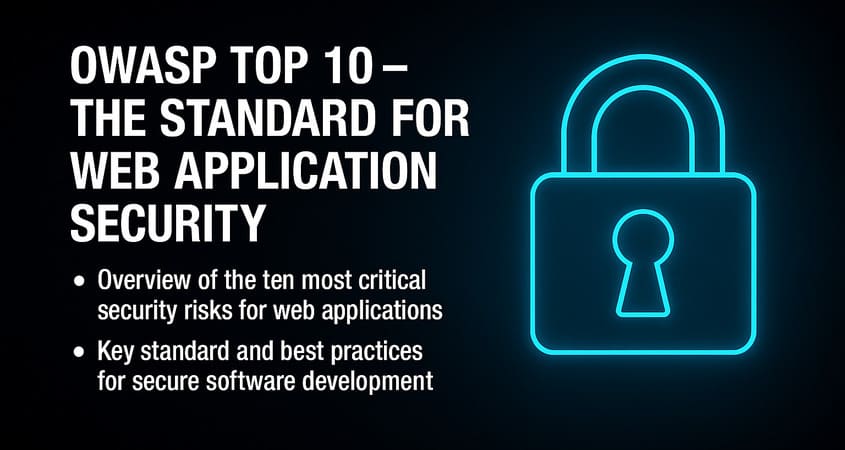OWASP Top 10 – The standard for web application security

In a world of growing digitization and automation, web application security has become one of the most critical areas of IT risk management. OWASP Top 10 is a ranking of the ten most significant security risks for web applications, published periodically by the OWASP (Open Web Application Security Project). This document is recognized as a global standard for application security and serves as a reference point for developers, system architects, auditors, and DevSecOps teams.
Table of Contents
ToggleWhat is OWASP?
OWASP is an international, non-profit organization that brings together security professionals, developers, architects, and researchers. Its mission is to promote secure software development, testing, and maintenance.
OWASP’s activities include:
- publishing frameworks, tools, and educational materials,
- developing open-source projects (e.g., OWASP ZAP, Dependency-Check),
- organizing global conferences (AppSec, Global AppSec),
- creating worldwide security standards, such as the OWASP Top 10.
OWASP Top 10 – Purpose and Importance
The OWASP Top 10 is not just a list of vulnerabilities – it is a manifest of the most common and critical security weaknesses found in web applications across the world.
Its purpose is to:
- raise awareness among developers and IT managers,
- facilitate the adoption of secure coding practices,
- standardize security audits,
- guide penetration testing and DevSecOps processes.
The latest version, OWASP Top 10:2021, is based on data collected from hundreds of thousands of applications analyzed by OWASP partners, giving it strong statistical credibility.
OWASP Top 10 – Categories of Risks (2021)
Below is a summary of the ten main categories of web application security risks according to OWASP 2021, with a short explanation for each.
A01: Broken Access Control
This is the most common and critical vulnerability.
It results from flaws in access control mechanisms, allowing users to access data or functionality they should not.
- Examples: URL ID manipulation, missing role validation, exposed admin endpoints.
- Recommendations: enforce least privilege, verify permissions server-side, avoid trusting client input.
A02: Cryptographic Failures
Previously known as Sensitive Data Exposure.
These occur when encryption is improperly implemented or missing for sensitive data (e.g., login credentials, credit card numbers, API keys).
- Examples: no TLS encryption, use of outdated algorithms (MD5, SHA-1), improper key management.
- Recommendations: use modern protocols (TLS 1.3), enforce HSTS, encrypt data at rest and in transit, follow NIST SP 800-57 guidelines for key management.
A03: Injection
Injection attacks involve inserting malicious code into an application (e.g., SQL, NoSQL, OS Command, LDAP).
- Examples: classic SQL Injection, Command Injection, deserialization attacks.
- Recommendations: use parameterized queries, ORM frameworks, validate and sanitize input, sandbox risky operations.
A04: Insecure Design
New in 2021.
This refers to security weaknesses introduced during the design phase rather than the implementation phase.
- Examples: missing threat models, unverified authorization flows, lack of architectural data validation.
- Recommendations: apply secure design principles, perform risk analysis, conduct threat modeling.
A05: Security Misconfiguration
The most common issue in production environments.
- Examples: default passwords, insecure HTTP headers, exposed admin interfaces, unnecessary services.
- Recommendations: automate hardening (e.g., Ansible, Chef), minimize exposure, scan configurations (e.g., CIS Benchmarks).
A06: Vulnerable and Outdated Components
Occurs when libraries or frameworks with known vulnerabilities are used.
- Examples: outdated versions of Log4j, Struts, OpenSSL.
- Recommendations: regular updates, automated dependency scanning (OWASP Dependency-Check, Snyk, GitHub Dependabot).
A07: Identification and Authentication Failures
Relates to weak implementation of authentication and session management mechanisms.
- Examples: no account lockout after failed attempts, plaintext password storage, weak session tokens.
- Recommendations: use MFA, bcrypt/Argon2, limit session lifetimes, adopt OAuth2 and OpenID Connect standards.
A08: Software and Data Integrity Failures
These arise when integrity of code or data in CI/CD pipelines is not validated.
- Examples: missing digital signatures for updates, unverified dependencies, untrusted sources.
- Recommendations: sign artifacts, verify checksums, secure the software supply chain (Software Supply Chain Security).
A09: Security Logging and Monitoring Failures
Lack of proper event logging and attack detection hampers effective incident response.
- Examples: missing access logs, undetected brute-force attempts, lack of SIEM integration.
- Recommendations: centralize logs (e.g., ELK, Splunk, Graylog), correlate events, conduct incident response testing.
A10: Server-Side Request Forgery (SSRF)
New in OWASP 2021.
SSRF attacks exploit server-side requests to unauthorized internal resources.
- Threats: data exfiltration, internal network scanning, access to cloud metadata (e.g., AWS EC2 Metadata API).
- Recommendations: implement URL whitelisting, validate input, isolate network services, block metadata access.
The Importance of OWASP Top 10 for Organizations
Adopting OWASP Top 10 principles helps organizations to:
- reduce the risk of data breaches,
- meet regulatory requirements (e.g., GDPR, NIS2, PCI DSS),
- increase customer and partner trust,
- lower audit and penetration testing costs,
- standardize security policies across the SDLC.
The OWASP Top 10 is a critical component of every DevSecOps strategy, embedding security throughout the CI/CD pipeline — from design to deployment. It is not merely a report, but a compass for web application security that highlights the most common issues and best practices. Every organization should treat it as a foundation for software security policies and mature risk management processes.
In the era of automation, cloud computing, and microservices, understanding and applying OWASP Top 10 principles is essential to building true cyber resilience.
Looking for more information? Check out these key references:
- OWASP Top 10 – Official Page (owasp.org) (https://owasp.org/Top10/)
- OWASP Testing Guide (https://owasp.org/www-project-web-security-testing-guide/)
- OWASP Application Security Verification Standard (ASVS) (https://owasp.org/ASVS/)
- NIST SP 800-53 & SP 800-218 (Secure Software Development Framework)
- ENISA Guidelines for Secure Software Development
INFO: The latest OWASP TOP10 report is from 2021. OWASP reports are published every four years – the previous one was released in 2017. According to official OWASP announcements, the next update (2025 edition) will be published in early November 2025. Once available, we will summarize the key changes and compare them with the 2021 report.
